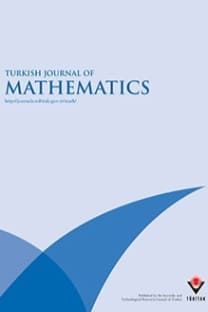Generalized weakly central reduced rings
$GWCN$ rings, $CN$ rings, reduced rings, strongly regular rings, left min-abel rings, exchange rings, clean rings
Generalized weakly central reduced rings
$GWCN$ rings, $CN$ rings, reduced rings, strongly regular rings, left min-abel rings, exchange rings, clean rings,
___
- Brown SH. Rings over which every simple module is rationally complete. Canada Math Bull 1973; 25: 693–701.
- Camillo VP, Yu HP. Exchange rings, units and idempotents. Comm Algebra 1994; 22: 4737–4749.
- Chen HY. On nil−semicommutative rings. Thai J Math 2011; 9: 37–47.
- Chen WX. On semiabelian π−regular rings. Intern J Math Sci 2007; 23: 1–10.
- Cohn PM. Reversible rings. Bull Korean Math Sci 1999; 31: 641–648.
- Contessa M. On pm−rings. Comm Algebra 1982; 10: 93–108.
- Drazin MP. Rings with central idempotent or nilpotent elements. Trans Amer Math Soc 1956; 187: 157–165.
- Fisher JW. Von Neumann regular rings versus V−rings. Proc Amer Math Soc 1974; 205: 101–119.
- Goodearl KR. Ring Theory: Non-singular Rings and Modules. New York, NY, USA: Marcel-Dekker, 1974.
- Handelman D. Perspectivity and cancellation in regular rings. J Algebra 1977; 48: 1–16.
- Hwang SU, Joen YC, Park KS. On N CI rings. Bull Korean Math Soc 2007; 44: 215–223.
- James PL. Commutativity conditions for rings: 1950-2005. Expositiones Math. 2007; 25: 165–174.
- Kim NK, Nam SB, Kim JY. On simple singular GP−injective modules. Comm Algebra 1999; 27: 2087–2096.
- Li NJ, Wei JC. N SF rings. J Yangzhou Univ 2011; 14: 1–4.
- Nicholson WK. Lifting idempotents and exchange rings. Trans Amer Math Soc 1997; 229: 269–178.
- Rege MB. On von Neumann regular rings and SF−rings. Math Japonica 1986; 31: 927–936.
- Tuganbaev A. Rings close to regular. Math Appl 2002; 99: 455–462.
- Vaserstein LN. Bass,first stable range condition. J Pure Appl Algebra 1984; 34: 319–330.
- Wang L, Wei JC, Li LB. NZI rings. Turk J Math 2013; 37: 781–792.
- Warfield RB. A Krull-Schmidt theorem for infinite sums of modules. Proc Amer Math Soc 1969; 22: 460–465.
- Wei ZX. A note on the commutativity of semiprime rings. J Math Resea Appl (China) 1985; 5: 109–110.
- Wei JC. On simple singular Y J−injective modules. Southea Asian Bull Math 2007; 31: 1–10.
- Wei JC. Certain rings whose simple singular modules are nil -injective. Turk J Math 2008; 32: 393–408.
- Wei JC. M C2 rings. Kyungp Math J 2008; 48: 651–663.
- Wei JC, Chen JH. N il−injective rings. Intern Electr J Algebra 2007; 2: 1–21.
- Wei JC, Chen JH. NPP rings, reduced rings and SNF rings. Intern Electr J Algebra 2008; 4: 9–26.
- Wei JC, Li LB. Quasi-normal rings. Comm Algebra 2010; 38: 1855–1868.
- Wei JC, Li LB. Strong DS rings. Southea Asian Bull Math 2009; 33: 375–390.
- Yu HP. On quasi-duo rings. Glasgow Math J 1995; 37: 21–31.
- ISSN: 1300-0098
- Yayın Aralığı: 6
- Yayıncı: TÜBİTAK
Quadratic recursive towers of function fields over F2
Seher TUTDERE, Henning STICHTENOTH
Moduli spaces of arrangements of 11 projective lines with a quintuple point
Cheng GONG, Mina TEICHER, Meirav AMRAM, Wan-Yuan XU
On isophote curves and their characterizations
Classification of metallic shaped hypersurfaces in real space forms
Cihan ÖZGÜR, Nihal ÖZGÜR YILMAZ
Super d-anti-magic labeling of subdivided $kC_{5}$
Sharp lower bounds for the Zagreb indices of unicyclic graphs
Batmend HOROLDAGVA, Kinkar Ch. DAS
Split extension classifiers in the category of precrossed modules of commutative algebras
Yaşar BOYACI, Tufan Sait KUZPINARI, Enver Önder USLU
$r$-ideals in commutative rings
Quadratic recursive towers of function fields over $\mathbb{F}_2$
